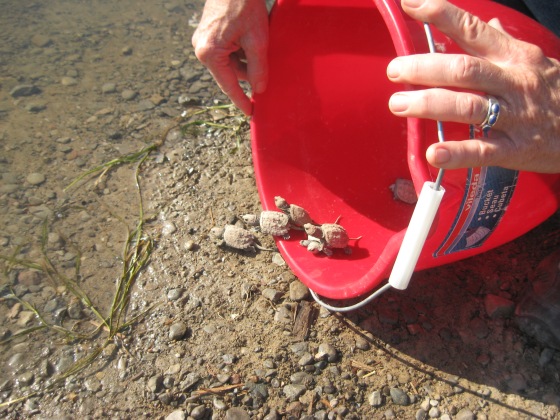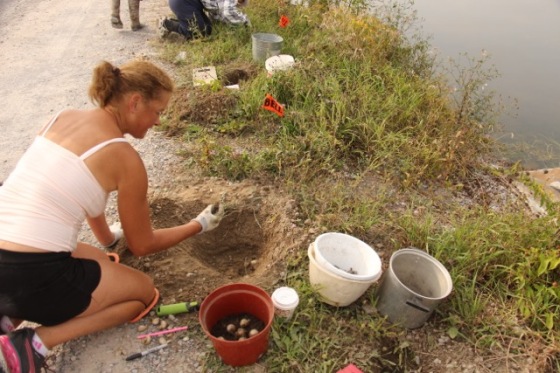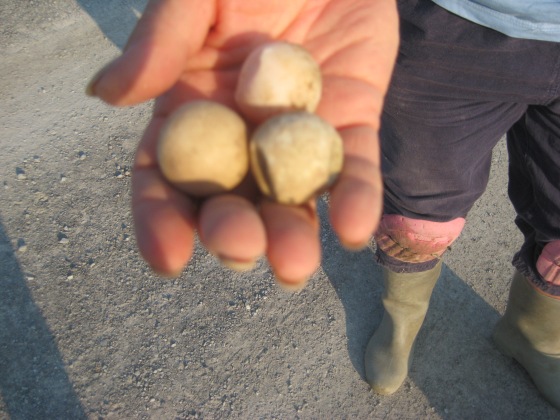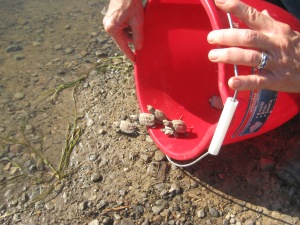(The environment is a necessary part of any memoir. It is the setting where the narrator’s story unfolds. Indeed, its existence is why the human species survives at all. Here, activist and naturalist Joan Norris relates how hundreds of doomed turtle eggs and hatchlings were given a chance to survive with strategic intervention.)
Have you ever heard of turtle nests migrating? Is that even possible? Well, it turns out turtle nests can indeed move from one place to another. They just need a little help from their friends.
Turtles ready to dig their nests look for a sunny embankment where the eggs can be incubated by the warm substrate. The Close Point Causeway on the south shore of Rice Lake, Ontario has this and it has a marsh on one side to serve as a nursery for the wee hatchlings. So, scores of snapping and map turtles travel here each spring to dig their nests. For about ten years now I have been protecting these nests. With help from friends, our success rate has grown each year so that last year almost 2,000 baby turtles hatched out.
This year would prove to be different. The road was scheduled to be paved the first week of September. Even if the shoulders were not paved, heavy machinery would, of necessity, be driving on the shoulders of this one lane road, crushing the nests.
But wait a minute! Aren’t all but one of Ontario’s eight native species of turtles at risk? Isn’t it against the law to disturb or destroy their nests? Well, one of the things I found very disheartening was to find out that even though snapping turtles and map turtles are listed as Species at Risk, they are given no protection under the Species at Risk Act. They are being “watched” but hunters can still legally trap them. Yep. List them as at risk and then give them no special consideration.
During a six-week period leading up to the road work, a friend and I explored every conceivable avenue and option to save the nests. We talked to the Ministry of Natural Resources, Conservation Authorities, experts in the field … hitting one dead end after another. As the deadline loomed and all other possible recourses dried up, we began to realize we had no other choice but to dig up and relocate the nests. So, at the proverbial two minutes to midnight, the decision was made, and the word went out for help. Word of mouth, phone calls, and emails.
And help came in spades! Within a day or two, a troop of turtle heroes armed with buckets and hand shovels descended on Close Point Road.
A biology professor from Trent University showed up with a dozen grad students who wanted to help. Members of the local naturalist club came by the carloads. Another biologist not only showed up with his co-workers, but they knew the ideal spot for the nests – a safe turtle nesting habitat newly created a few kilometers down the lake! People I didn’t know just showed up, saying they found out about the project from other people I didn’t know. Everyone rolled up their sleeves and got to work. Operation Turtle Migration had begun!
Each nest site had to be carefully opened and explored. Once the soft-shelled eggs were uncovered, they were delicately removed and placed in a temporary nest (bucket or other container) for transporting to their new site.
Much to our delight, many of the nests had hatchlings inside. The first to hatch stay in the nest until the rest of their siblings hatch out of their shells so that they can all dig out of the nest and make a run for the water together. But instead of having to run for their lives, these lucky babies got a free lift to the marsh, under the watchful gaze and big smiles of their human helpers.
Twenty-two nests containing hundreds of eggs were transplanted to the newly created nesting site, where they hatched out over the next few weeks, one nest at a time. With any luck, these turtles will come back to this nesting site when it’s time for them to lay, becoming the first of many generations to come.
It’s not always easy to know what is the right thing to do in life. Decisions are not always black and white, but often varying shades of gray. Although I had my reservations about moving the nests, I can look back now and say, yes, we called that one right. A couple of days after the Great Turtle Migration, the graders and rollers came and transformed the gravel road into another “paved paradise” as Joni Mitchell would say. But thanks to a small army of turtle guardians, the nests that had been there just a couple of days before had “migrated” north and hundreds of baby turtles that would have been running out in front of the paving equipment are now swimming around Rice Lake, helping to ensure the survival of a species at risk.
Thank you, Joan, for contributing this wonderful post on my blog!






What a wonderful and uplifting story. Thanks for posting!
LikeLike
Maybe Joan should write a children’s book, Tammy the Turtle, or something like that.
LikeLike
So interesting – thanks for sharing Diane. Elizabeth Pitura
LikeLike
Hi Elizabeth! I love this story too.
LikeLike
Great story. Thanks.
LikeLike
Thanks to Joan Norris and her Great Turtle Migration!
LikeLike
Well done, turtle guardians. Great story, Diane.
LikeLike
With guardians like these, our Earth is in a little less trouble.
LikeLiked by 1 person
Wonderful! On behalf of all the baby turtles and the generations to come, well done!
LikeLike
Carol, thanks for speaking for all those baby turtles!
LikeLike
Lovely story, Diane. So great that these animals were saved. Reminds me of one of my favorite Henry Beston quotations: “We need another and a wiser and perhaps a more mystical concept of animals. Remote from universal nature and living by complicated artifice, man in civilization surveys the creature through the glass of his knowledge and sees thereby a feather magnified and the whole image in distortion. We patronize them for their incompleteness, for their tragic fate for having taken form so far below ourselves. And therein do we err. For the animal shall not be measured by man. In a world older and more complete than ours, they move finished and complete, gifted with the extension of the senses we have lost or never attained, living by voices we shall never hear. They are not brethren, they are not underlings: they are other nations, caught with ourselves in the net of life and time, fellow prisoners of the splendour and travail of the earth.”
LikeLike
Beautiful quote, Renata, and so true. “…living by voices we shall never hear.” I’ve read it three times now. Thanks for bringing it to my attention.
LikeLike
Thank you for a happy ending story, Diane. I’ve always liked turtles, and it’s so wonderful to hear how these little babies got a helping hand.
Blessings ~ Wendy
LikeLike
Wendy, I agree. And good to hear that you have always like turtles. I read recently that the world’s oldest turtle is now 178.
LikeLike